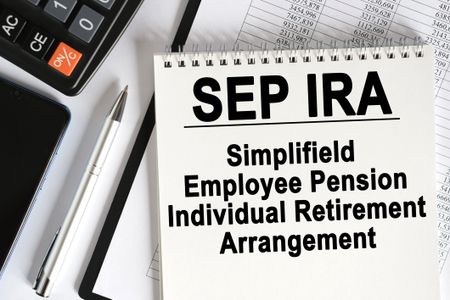Best Ways to Raid Your Retirement Accounts
When you have to tap your nest egg early, the key is to minimize the tax bite.

The problem: Your savings are all tied up in retirement accounts but you really need the money -- now. You know you shouldn't crack your nest egg until it's time to retire, but these are extraordinary times. Maybe your rainy-day fund has dried up, your credit-card rate has soared, or your home-equity line of credit has been yanked.
There are ways to tap your IRA or 401(k) without triggering the usual 10% early-withdrawal penalty. But unless you have a Roth IRA, you'll still have to pay income taxes at your regular rate on the money you take out. Some options depend on your age and whether you are employed.
Borrow from your 401(k)
If you are still working, you may be able to borrow up to half of the balance of your 401(k) or similar employer-based retirement savings account, up to a maximum of $50,000. (The majority of 401(k) plans allow loans, but specific rules are determined by the plan sponsor.)

Sign up for Kiplinger’s Free E-Newsletters
Profit and prosper with the best of expert advice on investing, taxes, retirement, personal finance and more - straight to your e-mail.
Profit and prosper with the best of expert advice - straight to your e-mail.
On the plus side, interest rates on 401(k) loans tend be lower than you will find elsewhere. Because you are borrowing from yourself, your credit score doesn't matter and your loan repayments plus interest go back into your account.
Normally, you have up to five years to repay your loan (longer if the money is used as a down payment on a first home). But if you fail to pay it back on time, the unpaid balance will be treated as an early distribution and will be subject to taxes and the 10% early-withdrawal penalty if you're younger than 59½. If you lose or leave your job, your loan payoff is usually due within 90 days -- at a time when you may be least able to repay it. So don't consider borrowing from your retirement plan unless your job is secure.
New research from the Federal Reserve suggests that borrowing from a 401(k) may make sense if the interest rate you would pay for an alternative loan, such as a car loan or credit-card , is higher than the rate of return you expect to earn on investments inside your 401(k) account. A 401(k) loan-handled properly could be the least costly source of funds, according to economists Geng Li and Paul Smith. They predict that the recent tightening of terms in mortgage and consumer lending will boost 401(k) borrowing.
But handled improperly, borrowing from your 401(k) can inflict major damage to your long-term savings. The key is whether you continue to contribute to your 401(k) plan while you repay the loan.
Say you have $40,000 in your 401(k) plan earning an average annual return of 7%. (Yes, such returns, or even higher, are possible now that the stock market has started to recover from the lows it reached in March.) Also assume that you contribute $200 a week to your 401(k). If you borrow $20,000 from your plan at 5% interest and repay it over five years -- but you stop contributing to your plan in the interim -- that loan will cost you more than $365,000 in lost savings by the time you retire in 30 years. However, if you continue to contribute your usual $200 a week while you make the loan payments, the long-term impact on your saving would be less than $8,000.
Borrowing from your 401(k) is a much better alternative than requesting a hardship withdrawal, which is generally reserved for dire financial situations, such as preventing foreclosure. Hardship withdrawals are treated as early distributions and are subject to taxes and penalties. So, for example, if you're in the 25% federal income tax bracket and your state tax rate is 5% and you are younger than 59½, you could lose 40% of your 401(k) distribution to taxes and penalties. Once you take a hardship withdrawal, you can’t put it back so it permanently reduces the size of your nest egg. And, the law prohibits you from making new contributions for at least six months following a hardship withdrawal.
Dodge the early-withdrawal penalty
If you are 55 or older and you leave your job, whether by choice or because you've been laid off or decided to retire early, you can take withdrawals from your 401(k), 403(b) or federal Thrift Savings Plan penalty-free. (You'll still have to pay income taxes on any distributions.) If you are a state or local government employee with a 457 plan, you can withdraw your savings anytime penalty-free, regardless of your age, after you leave your job.
If, however, you roll over your retirement funds to an IRA, you lose the early-out option. Normally, you pay a 10% early-withdrawal penalty, in addition to income taxes, when you withdraw funds from a traditional IRA before you turn 59½. (and you can't borrow from your IRA). But that doesn't mean you can't tap an IRA early.
You can skip the 10% penalty if you use your IRA withdrawal to pay for college expenses for you, your spouse or a dependent, or to put toward the purchase of your first home (up to a maximum $10,000). The penalty is also waived if you become disabled; if you use the money to pay medical expenses in excess of 7.5% of your adjusted gross income; or, under certain conditions, if you are unemployed and use the money to pay for health-insurance premiums.
There is another way to avoid the 10% early-withdrawal penalty, regardless of how you spend the money. You can take a "series of substantially equal distributions," based on your life expectancy for at least five years and at least until you are 59½ years old-whichever is longer. You can even split off a part of your IRA and take distributions based on that one account, reducing the amount you can access each year but protecting the remainder of your nest egg.
This strategy, known as a 72t distribution, works best if you're in your fifties and can commit to steady distributions for five years or longer. Once you choose a payout method, you must stick to it. The penalty for deviating from a 72t distribution schedule is steep: You'll pay the 10% penalty retroactive to your first withdrawal, plus interest.
There are three methods of calculating the distribution, so you can choose whichever one works best for you. Based on the 3.32% interest rate in effect for July 2009 (the IRS publishes rates monthly), a 52-year-old man with a $400,000 IRA would be required to take distributions of about $12,300 a year under the minimum distribution method and about $20,300 under the alternative amortization and annuity methods. You can get your own estimate using the free 72t calculators at www.401kplanning.org.
With current interest rates so low, 72t distributions are smaller than they were even two years ago, when rates were closer to 6%. "There are a lot of people who would like to retire early, but the low payouts don't meet their income needs," says J. Graydon Coghlan, president of Coghlan Financial Group in San Diego. "The 72t interest rate is a one-time calculation," adds Coghlan. Whatever the rate is when you start is the one you use for the entire payout.
Tap a Roth IRA
Because there are no upfront tax breaks when you contribute to a Roth IRA, you can withdraw your contributions (but not earnings) tax-free and penalty-free at any time. That makes Roth IRA money the easiest to access in hard times.
But think twice before cashing in your Roth IRA, considered by many to be the holy grail of savings vehicles. Contributions and earnings grow tax-free inside a Roth IRA, and all distributions are tax-free and penalty-free once you are 59½ and the account has been open at least five years. The longer you allow the assets to grow, the bigger your pile of tax-free assets will be.
Roth IRAs offer estate-planning advantages over traditional IRAs, too. They have no minimum distribution requirements and you can continue to contribute, regardless of age, as long as you have earned income from a job. That means if you don't need the money, you can build a substantial legacy for your heirs. They'll also thank you for using a Roth: Beneficiaries pay no income taxes on inherited Roth IRAs.
Get Kiplinger Today newsletter — free
Profit and prosper with the best of Kiplinger's advice on investing, taxes, retirement, personal finance and much more. Delivered daily. Enter your email in the box and click Sign Me Up.

-
 April RMD? Five Tax Strategies to Manage Your 2025 Income
April RMD? Five Tax Strategies to Manage Your 2025 IncomeTaxable Income The April 1, 2025, deadline for required minimum distributions (RMDs) is fast approaching for retirees who turned 73 in 2024.
By Kelley R. Taylor Last updated
-
 Rising AI Demand Stokes Undersea Investments
Rising AI Demand Stokes Undersea InvestmentsThe Kiplinger Letter As demand soars for AI, there’s a need to transport huge amounts of data across oceans. Tech giants have big plans for new submarine cables, including the longest ever.
By John Miley Published
-
 457 Plan Contribution Limits for 2025
457 Plan Contribution Limits for 2025Retirement plans There are higher 457 plan contribution limits for state and local government workers in 2025. That's good news for state and local government employees
By Kathryn Pomroy Last updated
-
 Medicare Basics: 11 Things You Need to Know
Medicare Basics: 11 Things You Need to KnowMedicare There's Medicare Part A, Part B, Part D, Medigap plans, Medicare Advantage plans and so on. We sort out the confusion about signing up for Medicare — and much more.
By Catherine Siskos Last updated
-
 The Seven Worst Assets to Leave Your Kids or Grandkids
The Seven Worst Assets to Leave Your Kids or Grandkidsinheritance Leaving these assets to your loved ones may be more trouble than it’s worth. Here's how to avoid adding to their grief after you're gone.
By David Rodeck Last updated
-
 SEP IRA Contribution Limits for 2025
SEP IRA Contribution Limits for 2025SEP IRA A good option for small business owners, SEP IRAs allow individual annual contributions of as much as $69,000 in 2024 and $70,000 in 2025..
By Jackie Stewart Last updated
-
 Roth IRA Contribution Limits for 2025
Roth IRA Contribution Limits for 2025Roth IRAs Roth IRA contribution limits have gone up. Here's what you need to know.
By Jackie Stewart Last updated
-
 SIMPLE IRA Contribution Limits for 2025
SIMPLE IRA Contribution Limits for 2025simple IRA The SIMPLE IRA contribution limit increased by $500 for 2025. Workers at small businesses can contribute up to $16,500 or $20,000 if 50 or over and $21,750 if 60-63.
By Jackie Stewart Last updated
-
 457 Contribution Limits for 2024
457 Contribution Limits for 2024retirement plans State and local government workers can contribute more to their 457 plans in 2024 than in 2023.
By Jackie Stewart Published
-
 Roth 401(k) Contribution Limits for 2025
Roth 401(k) Contribution Limits for 2025retirement plans The Roth 401(k) contribution limit for 2025 increased, and workers who are 50 and older can save even more.
By Jackie Stewart Last updated